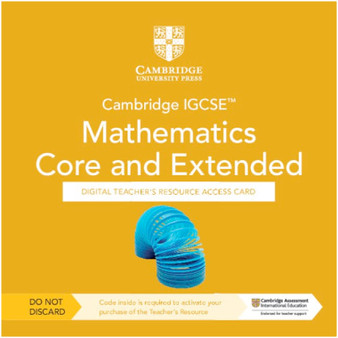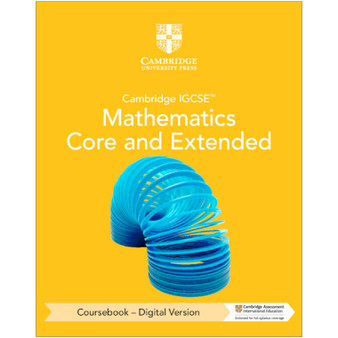Product Description
Cambridge IGCSE™ Mathematics Core and Extended Digital Teacher's Resource (5 Years Access)
Author/s: Dicky Susanto
Format: Digital
Feel fully supported in teaching Cambridge IGCSE™ Mathematics with the digital teacher’s resource, aligned to the Core and Extended coursebook.
The resource includes comprehensive guidance such as advice on teaching strategies, lesson plan templates, teaching notes, homework ideas, PowerPoint presentations and answers to the coursebook and practice book activities.
Knowledge Check, the digital formative assessment tool, helps teachers identify potential student misconceptions and understand whether learners are ready for certain topics, providing targeted teaching ideas that can be carried out with a class.
Features:
- Links to the syllabus learning objectives at the start of each chapter.
- Lesson ideas save valuable planning time and keep your classroom focussed.
- Highlighted common mathematical misconceptions and advice for working through them help you guide students.
- Homework ideas enable you to challenge students in new ways.
- PowerPoint presentations provide ready-made front-of-class materials.
- Differentiation suggestions enable you to support and challenge all students, no matter what their ability.
- A new pre-teaching check of foundation skills will be available soon to help you understand whether learners are ready for certain topics.
- The Teacher's Resource includes instructions on how to use Knowledge Check, the digital formative assessment tool.
Contents:
1. Review of number concepts
2. Making sense of algebra
3. Lines, angles and shapes
4. Collecting, organising and displaying data
5. Fractions, percentages and standard form
6. Equations, factors and formulae
7. Perimeter, area and volume
8. Introduction to probability
9. Sequences, surds and sets
10. Straight lines and quadratic equations
11. Pythagoras' theorem and similar shapes
12. Averages and measures of spread
13. Understanding measurement
14. Further solving of equations and inequalities
15. Scale drawings, bearings and trigonometry
16. Scatter diagrams and correlation
17. Managing money
18. Curved graphs
19. Symmetry
20. Histograms and cumulative frequency diagrams
21. Ratio, rate and proportion
22. More equations, formulae and functions
23. Transformations and vectors
24. Probability using tree diagrams and Venn diagrams
Answers
Glossary.






